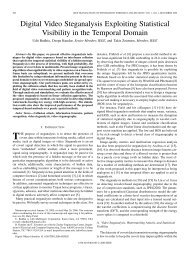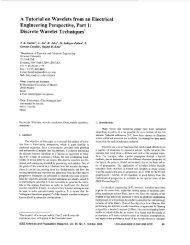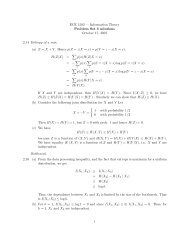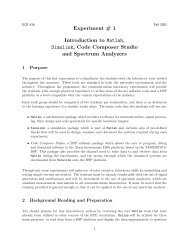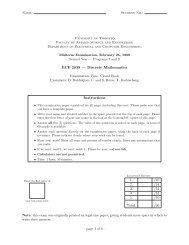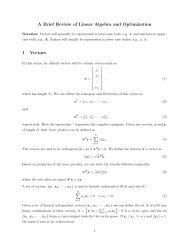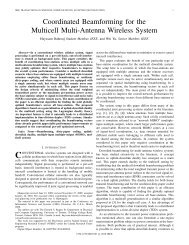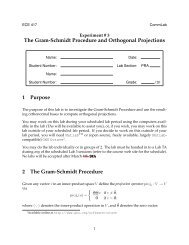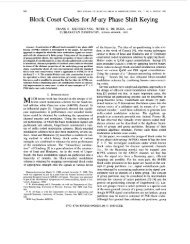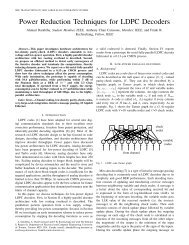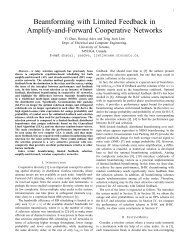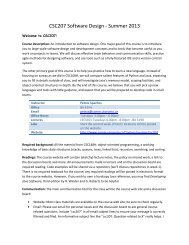Distortion Analysis of Mos Track-and-hold Sampling Mixers Using ...
Distortion Analysis of Mos Track-and-hold Sampling Mixers Using ...
Distortion Analysis of Mos Track-and-hold Sampling Mixers Using ...
You also want an ePaper? Increase the reach of your titles
YUMPU automatically turns print PDFs into web optimized ePapers that Google loves.
IEEE TRANSACTIONS ON CIRCUITS AND SYSTEMS—II: ANALOG AND DIGITAL SIGNAL PROCESSING, VOL. 46, NO. 2, FEBRUARY 1999 101<br />
<strong>Distortion</strong> <strong>Analysis</strong> <strong>of</strong> MOS <strong>Track</strong>-<strong>and</strong>-Hold<br />
<strong>Sampling</strong> <strong>Mixers</strong> <strong>Using</strong> Time-Varying Volterra Series<br />
Wei Yu, Subhajit Sen, <strong>and</strong> Bosco H. Leung, Senior Member, IEEE<br />
Abstract—A time-varying theory <strong>of</strong> Volterra series is developed<br />
<strong>and</strong> applied in the sampled-data domain to solve for harmonic<br />
<strong>and</strong> intermodulation distortion <strong>of</strong> a MOS-based track-<strong>and</strong>-<strong>hold</strong><br />
sampling mixer with a nonzero fall-time LO waveform. <strong>Distortion</strong><br />
due to sampling error is also calculated. These results, when<br />
combined with the continuous-time solution, quantify harmonic<br />
<strong>and</strong> intermodulation distortion <strong>of</strong> a track-<strong>and</strong>-<strong>hold</strong> type mixer<br />
completely. Closed-form solutions are obtained. As a practical<br />
consequence, it is shown that for certain fall-time, the distortion<br />
<strong>of</strong> track-<strong>and</strong>-<strong>hold</strong> mixers can be better than what would be<br />
predicted by a simple application <strong>of</strong> time-invariant Volterra series<br />
theory.<br />
Index Terms— Harmonic distortion, intermodulation distortion,<br />
intermediate frequency (IF), radio frequency (RF), timevarying<br />
Volterra series, track-<strong>and</strong>-<strong>hold</strong> sampling mixer.<br />
I. INTRODUCTION<br />
INCREASING dem<strong>and</strong> for digital wireless personal communication<br />
devices, <strong>and</strong> steady improvements in the MOS<br />
device performance <strong>of</strong> scaled VLSI technologies, have allowed<br />
the feasibility <strong>of</strong> performing A/D conversion on radi<strong>of</strong>requency<br />
(RF) signals directly or on their mixed down (IF)<br />
versions [1], [2]. Early A/D conversion <strong>of</strong> the received signal<br />
in a receiver chain pushes front-end signal processing<br />
functions such as channel-selection filtering <strong>and</strong> automatic<br />
gain control (AGC) into the digital domain, <strong>and</strong> thus helps<br />
to improve tolerance against process variations inherent in<br />
analog dominated front-end architectures <strong>and</strong> therefore the<br />
overall performance <strong>of</strong> the receiver. The key element crucial<br />
for good distortion performance <strong>of</strong> an A/D converter that<br />
digitizes RF signals is the track-<strong>and</strong>-<strong>hold</strong> circuit at the input<br />
<strong>of</strong> the A/D converter. This is because unlike a conventional<br />
baseb<strong>and</strong> A/D converter, the track-<strong>and</strong>-<strong>hold</strong> circuit in an RF<br />
A/D application is inherently a mixer that mixes the RF signal<br />
down to baseb<strong>and</strong> or a lower IF frequency in the process<br />
Manuscript received March 23, 1997; revised November 14, 1998. This<br />
work was supported by the Department <strong>of</strong> Electrical <strong>and</strong> Computer Engineering,<br />
University <strong>of</strong> Waterloo, <strong>and</strong> by the National Science <strong>and</strong> Engineering<br />
Research Council (NSERC) <strong>of</strong> Canada. This paper was recommended by<br />
Associate Editor Y. Inoue.<br />
W. Yu was with the Department <strong>of</strong> Electrical <strong>and</strong> Computer Engineering,<br />
University <strong>of</strong> Waterloo, Waterloo, Ont., N2L 3G1, Canada. He is now with<br />
the Information Systems Laboratory, Department <strong>of</strong> Electrical Engineering,<br />
Stanford University, Stanford, CA 94305 USA (e-mail: weiyu@stanford.edu).<br />
S. Sen was with the Department <strong>of</strong> Electrical <strong>and</strong> Computer Engineering,<br />
University <strong>of</strong> Waterloo, Waterloo, Ont., N2L 3G1, Canada. He is now with<br />
Arcus Technology Limited in Bangalore, India (e-mail: sen@arcustech.com).<br />
B. H. Leung is with the Department <strong>of</strong> Electrical <strong>and</strong> Computer Engineering,<br />
University <strong>of</strong> Waterloo, Waterloo, Ont., N2L 3G1, Canada (e-mail:<br />
bleung@sun14.vlsi.uwaterloo.ca).<br />
Publisher Item Identifier S 1057-7130(99)01746-2.<br />
<strong>of</strong> continuous-time to discrete-time conversion. Compared to<br />
the conversion <strong>of</strong> a b<strong>and</strong>-limited signal in a conventional<br />
Nyquist-rate A/D converter, the mixing down process in a<br />
narrow-b<strong>and</strong> VHF or UHF signal is much more nonlinear<br />
with nonlinear products increasing with input RF frequency.<br />
Linearity is crucial because the presence <strong>of</strong> adjacent channel<br />
interfering signals at the input generates spurious components<br />
in the desired channel b<strong>and</strong>. The track-<strong>and</strong>-<strong>hold</strong> mixer also<br />
differs from a conventional mixer (such as a Gilbert multiplier)<br />
in that the frequency <strong>of</strong> the sampling clock (which serves as<br />
the equivalent <strong>of</strong> a local oscillator) may be a submultiple <strong>of</strong><br />
the local oscillator (LO) frequency in a conventional mixer.<br />
In a subsampling track-<strong>and</strong>-<strong>hold</strong> mixer, the th harmonic<br />
<strong>of</strong> a sampling-clock with fundamental frequency may be<br />
mixed down with a carrier-tone at frequency to generate a<br />
baseb<strong>and</strong> tone at frequency ( ).<br />
In this paper, the harmonic <strong>and</strong> intermodulation distortion<br />
<strong>of</strong> MOS track-<strong>and</strong>-<strong>hold</strong> mixers is thoroughly analyzed <strong>and</strong><br />
related with simulation results. It is shown that a complete<br />
picture <strong>of</strong> distortion can be obtained by applying Volterra<br />
series analysis, hitherto applied only to continuous-time timeinvariant<br />
nonlinear systems, to time-varying circuits that are<br />
observed every clock period in the discrete-time domain such<br />
as in the case <strong>of</strong> a track-<strong>and</strong>-<strong>hold</strong> circuits in A/D converters.<br />
We have done this by developing a theory <strong>of</strong> Volterra analysis<br />
for time-varying systems valid under the assumption that the<br />
time-constant <strong>of</strong> the circuit is much smaller than the sample<br />
clock period. We have demonstrated that the incorporation<br />
<strong>of</strong> the time-varying analysis to Volterra series is essential for<br />
an accurate estimation <strong>of</strong> distortion for arbitrary fall-time in<br />
the sampling clock waveform. The closed-form formulas we<br />
obtained are useful in providing physical insights to the circuit<br />
designer. Successful applications which used these formulas in<br />
designing the front-end sampling mixer have been reported, for<br />
example, in an 150-MHz 13-bit 12-mW A/D converter in [3],<br />
<strong>and</strong> in a 400-MHz 12-bit 18-mW A/D converter in [4].<br />
The rest <strong>of</strong> the paper is organized as follows. Section II<br />
explains the basic operation <strong>of</strong> the track-<strong>and</strong>-<strong>hold</strong> circuit as a<br />
mixer under the assumption <strong>of</strong> zero fall-time LO waveform.<br />
Expressions for harmonic distortion (HD <strong>and</strong> HD ) <strong>and</strong><br />
intermodulation (IM <strong>and</strong> IM ) are derived using Volterra<br />
Series. The difficulty <strong>of</strong> extending this result to an arbitrary<br />
gate waveform is explained. Section III develops the<br />
theory <strong>of</strong> time-varying Volterra Series <strong>and</strong> shows that it is<br />
possible to extend the theory to time-varying systems by<br />
assuming that the output is observed in the sampled-date<br />
domain. Expressions for time-varying distortion are derived<br />
1057–7130/99$10.00 © 1999 IEEE
102 IEEE TRANSACTIONS ON CIRCUITS AND SYSTEMS—II: ANALOG AND DIGITAL SIGNAL PROCESSING, VOL. 46, NO. 2, FEBRUARY 1999<br />
Fig. 1.<br />
A track-<strong>and</strong>-<strong>hold</strong> mixer.<br />
Fig. 2.<br />
Mixing distortion using two tones.<br />
for the case <strong>of</strong> a simple track-<strong>and</strong>-<strong>hold</strong> mixer. In Section IV,<br />
sampling distortion is analyzed <strong>and</strong> expressions for harmonic<br />
<strong>and</strong> intermodulation distortion are derived. Section V describes<br />
SPICE simulation results for the simple track-<strong>and</strong>-<strong>hold</strong> mixer.<br />
These results are then explained using the theoretical results<br />
on the continuous-time, time-varying, <strong>and</strong> sampling distortion.<br />
Section VI analyzes the practical scheme <strong>of</strong> bottom-plate<br />
sampling using the theory developed. Conclusions are drawn<br />
in Section VII.<br />
II. TRACK-AND-HOLD SAMPLING MIXER<br />
A. Mixer Operation<br />
A single switch track-<strong>and</strong>-<strong>hold</strong> sampling mixer consists <strong>of</strong><br />
a MOS transistor followed by a sampling capacitor (Fig. 1).<br />
The input is at RF or IF frequency. As applied at the<br />
gate goes high, the output tracks the input; as goes<br />
low, the output is sampled <strong>and</strong> held on the capacitor. The<br />
output is considered in the sampled-data domain.<br />
Before analyzing distortion, let us first define the terminology<br />
used in this paper. Suppose that a single pure sinusoidal<br />
input is applied at the input <strong>of</strong> the circuit, in this<br />
case to , we define the harmonic distortion <strong>of</strong> th order<br />
to be the magnitude <strong>of</strong> the term at the output .If<br />
two tones are applied at the input, frequencies at the sum <strong>and</strong><br />
difference <strong>of</strong> input frequencies are present at the output. So,<br />
two different kinds <strong>of</strong> second order intermodulation (IM ) are<br />
possible. For an input <strong>of</strong> ,IM is defined as<br />
the magnitude <strong>of</strong><br />
term at the output, <strong>and</strong> IM<br />
that <strong>of</strong><br />
term. Likewise, intermodulation <strong>of</strong> third<br />
order (or IM ) is defined as the magnitude <strong>of</strong><br />
term when an input <strong>of</strong><br />
is applied. The<br />
physical origin <strong>of</strong> HD <strong>and</strong> IM is the same, <strong>and</strong> HD is<br />
related to IM by a factor <strong>of</strong> 2. So, we are more interested<br />
in IM than IM . In the following analysis, unless explicitly<br />
specified, IM refers to IM .<br />
For example, in the case that the RF input contains two tones<br />
at frequencies (say at 100.3 MHz) <strong>and</strong> (say at 100.4<br />
MHz), respectively, with a sampling clock frequency at<br />
100 MHz. The components visible in the baseb<strong>and</strong> are shown<br />
in Fig. 2. The 100-kHz component is the IM component<br />
at . The 200-kHz component is due to IM at<br />
(200.2 MHz) mixed down to baseb<strong>and</strong>. The<br />
component at 700 kHz is the IM component at<br />
(200.7 MHz) mixed down. We also observe HD components<br />
at 600 <strong>and</strong> 800 kHz as well as HD component at 900<br />
kHz. We may note that by using a differential architecture,<br />
the even order distortion (e.g., HD , IM ) may be made<br />
considerably smaller (by the mismatch factor) than in a singleended<br />
architecture.<br />
A rigorous distortion analysis <strong>of</strong> the simple track-<strong>and</strong><strong>hold</strong><br />
circuit with arbitrary input frequency <strong>and</strong> arbitrary LO<br />
waveform is difficult for the following reasons.<br />
• The relation between drain current <strong>and</strong> terminal voltages<br />
is nonlinear.<br />
• The body effect <strong>and</strong> bias-dependent junction capacitors<br />
produce additional nonlinearities.<br />
• The circuit is time varying due to the modulation <strong>of</strong> drainsource<br />
conductance by the applied gate LO waveform.<br />
• The precise instant <strong>of</strong> sampling depends not only on<br />
the LO waveform but also on the input amplitude <strong>and</strong><br />
frequency resulting in sampling distortion.<br />
Previous work on track-<strong>and</strong>-<strong>hold</strong> distortion focused on its<br />
application in baseb<strong>and</strong> A/D converters [5], [6]. These have<br />
mainly tackled the distortion problem <strong>of</strong> a CMOS switch<br />
by isolating the distortion into the “tracking error” <strong>and</strong> the<br />
“aperture error” components with low-frequency single-tone<br />
inputs. They used assumptions that are not valid for track<strong>and</strong>-<strong>hold</strong><br />
mixers applications, the most important <strong>of</strong> which is<br />
the circuit time-invariant assumption. In [7], track-<strong>and</strong>-<strong>hold</strong><br />
type mixers for continuous-time output using Volterra Series<br />
approach were analyzed. Again, the analysis did not take into<br />
account the sampling <strong>and</strong> the time-varying nature <strong>of</strong> the circuit<br />
due to periodic but arbitrary gate LO waveforms.<br />
In the following, we propose to analyze distortion using<br />
time-varying Volterra series. To simplify the problem, we<br />
will abstract the most essential features <strong>of</strong> MOS track-<strong>and</strong><strong>hold</strong><br />
distortion by excluding the nonlinear bias-dependent<br />
components <strong>of</strong> junction capacitors <strong>and</strong> body effect from the<br />
MOS transistor model. Further analysis incorporating these<br />
second order effects results in a slight modification <strong>of</strong> only a<br />
few decibels. As a first step, we will solve for mixer distortion<br />
in the continuous-time mode, which corresponds to the case<br />
where LO waveform has a sharp cut<strong>of</strong>f. This also serves
YU et al.: DISTORTION ANALYSIS OF MOS TRACK-AND-HOLD SAMPLING MIXERS 103<br />
ON. (This is true even for high-frequency RF if a subsampling<br />
technique is used with a sufficient subsampling factor.) Under<br />
this condition, the distortion components seen in the discretetime<br />
frequency domain are the same as that for the case<br />
when the track-<strong>and</strong>-<strong>hold</strong> is working in the continuous-time<br />
mode with the gate voltage at <strong>and</strong> the MOS transistor<br />
stays ON. Therefore, to calculate distortion components for<br />
the ideal sampling case, we only need to analyze distortion<br />
for the continuous-time mode, which can be done using the<br />
time-invariant Volterra series theory.<br />
Fig. 3.<br />
Mixing using ideal sampling.<br />
C. Volterra Series <strong>and</strong> Harmonic <strong>Distortion</strong><br />
Under some general continuity conditions, a time-invariant<br />
system may be exp<strong>and</strong>ed into the sum <strong>of</strong> a linear term, a<br />
second-order term, <strong>and</strong> a third-order term, etc. [8]. Mathematically,<br />
if the input is , the output is represented by<br />
a series <strong>of</strong> the type,<br />
to illustrate the essential steps in applying Volterra series in<br />
distortion analysis.<br />
B. Mixer <strong>Using</strong> Ideal <strong>Sampling</strong><br />
The mixer operation under ideal sampling can be approximated<br />
by the following simplified model. We assume that<br />
a constant high voltage is applied at the gate, an RF signal<br />
at frequency is applied at the input, <strong>and</strong> that the output<br />
is sampled using an ideal sampling process. Since the circuit<br />
is nonlinear, we expect the input signal to be attenuated by<br />
the gain <strong>of</strong> the network along with harmonic components at<br />
where 2, 3, , as shown in Fig. 3(b). The ideal<br />
sampling process followed by an ideal low-pass filter with a<br />
cut<strong>of</strong>f frequency at /2 is then applied to the output. The<br />
effect is to replicate the output spectrum by shifting it by ,<br />
where 1, 2, , so that a shifted component <strong>of</strong> output is<br />
mixed down to near DC. This is shown in Fig. 3(d). We note<br />
that harmonic components at now reappear near DC at<br />
<strong>and</strong> close to in the baseb<strong>and</strong>. We may<br />
also note that it is possible to mix down the output to the same<br />
positions in the baseb<strong>and</strong> by using a sampling clock with a<br />
frequency that is a subharmonic <strong>of</strong> (i.e., subsampling). The<br />
observation is that the harmonic distortion <strong>of</strong> the mixer without<br />
sampling [i.e., Fig. 3(b)] is the same as the harmonic distortion<br />
<strong>of</strong> the sampled signal in the baseb<strong>and</strong> [i.e., Fig. 3(d)] if ideal<br />
sampling is assumed. Therefore, under the ideal sampling<br />
condition, harmonic distortion can be calculated as if sampling<br />
has not occurred, <strong>and</strong> the system is operating in the continuoustime<br />
mode.<br />
The mixing process with ideal sampling just described may<br />
now be used to approximate a track-<strong>and</strong>-<strong>hold</strong> circuit at whose<br />
gate an ideal square-wave is applied. When the gate voltage<br />
is at , the MOS transistor is in the triode region <strong>and</strong> the<br />
output tracks the input voltage. When the MOS turns OFF<br />
instantaneously, as in the case <strong>of</strong> an ideal square-wave gate<br />
voltage, the tracked output voltage is held onto the capacitor.<br />
Assuming that the time-constant <strong>of</strong> the circuit is much smaller<br />
than the gate ON period, the output voltage reaches a steadystate<br />
value within several time-constants after the MOS turns<br />
whose convergence is uniform. More succinctly, we write,<br />
(2)<br />
where represents the th order operator with kernel .<br />
This series is called the Volterra series. It can be shown that<br />
Volterra kernels form a basis for sufficiently well-behaved<br />
systems, i.e., a mildly nonlinear system can be exp<strong>and</strong>ed in<br />
a Volterra series in one <strong>and</strong> only one way.<br />
Exp<strong>and</strong>ing a system in Volterra series enables us to find<br />
its frequency response <strong>and</strong> hence its sinusoidal response, so<br />
Volterra series is directly related to harmonic distortion [9].<br />
For example, the response to a sinusoidal input for a secondorder<br />
system contains a term at twice the input frequency <strong>and</strong><br />
a term at DC. The magnitude <strong>of</strong> each term is related to the<br />
corresponding terms in the Volterra series. More specifically,<br />
for an input <strong>of</strong><br />
, the output is<br />
The third-order term can be derived in a similar way. Following<br />
the definition for harmonic distortion, harmonic distortion<br />
is related to Volterra kernels in the following way:<br />
(1)<br />
HD (3)<br />
HD (4)
104 IEEE TRANSACTIONS ON CIRCUITS AND SYSTEMS—II: ANALOG AND DIGITAL SIGNAL PROCESSING, VOL. 46, NO. 2, FEBRUARY 1999<br />
Similarly, intermodulation can be quantified as well:<br />
IM (5)<br />
IM (6)<br />
Therefore, obtaining the Volterra series coefficients is the key<br />
in calculating harmonic distortion <strong>and</strong> intermodulation.<br />
D. MOS Mixer Volterra Coefficients<br />
We now analyze harmonic distortion <strong>of</strong> an ideal sampling<br />
mixer using the continuous-time model by calculating its<br />
Volterra coefficients. First, it can be shown by a Volterra<br />
analysis that at sufficiently low frequencies the distortion<br />
is mainly determined by the nonlinear source-to-drain –<br />
characteristic <strong>of</strong> the MOS transistor <strong>and</strong> that distortion due to<br />
bias-dependent junction capacitance is quite small for typical<br />
values <strong>of</strong> MOS model parameters. We also choose to ignore<br />
body effect for simplicity in analysis, but note that this choice<br />
modifies neither our method <strong>of</strong> distortion analysis nor the<br />
significant conclusions regarding distortion in MOS track<strong>and</strong>-<strong>hold</strong><br />
mixers. Further, the only parasitic capacitance <strong>of</strong><br />
importance is the junction capacitance at the output side whose<br />
effect is to increase the value <strong>of</strong> the sampling capacitor.<br />
Therefore, in deriving the Volterra series coefficient, we can<br />
assume the configuration in Fig. 1 <strong>and</strong> use the most basic MOS<br />
equation<br />
where , <strong>and</strong> is the thres<strong>hold</strong> voltage. Either<br />
the input or the output side may be regarded as source. The<br />
system differential equation thus becomes<br />
(7)<br />
(8)<br />
The solutions to this set <strong>of</strong> differential equations are the<br />
Volterra coefficients , , <strong>and</strong> . Since we assume a<br />
constant gate voltage, hence a constant , we can show that<br />
(10)<br />
(11)<br />
(12)<br />
where the assumption <strong>of</strong> small time-constant ( )is<br />
used, <strong>and</strong> also the expressions are symmetrized. Substituting<br />
(10)–(12) into (3)–(6) yields the harmonic distortion <strong>and</strong><br />
intermodulation<br />
HD (13)<br />
HD (14)<br />
IM (15)<br />
IM (16)<br />
It must be emphasized that the above analysis assumes a<br />
constant gate voltage. This applies to the case <strong>of</strong> perfect square<br />
LO sampling if the system time-constant is much smaller than<br />
the sampling period. However, if the sampling-clock voltage<br />
deviates from the ideal square wave, two effects start to emerge<br />
which will invalidate the continuous-time model. If the gate<br />
voltage falling edge is not instantaneous, the approximate<br />
time-constant <strong>of</strong> the circuit, as given by<br />
where . Express in its Volterra series<br />
where , substitute the expansion into (8),<br />
<strong>and</strong> keep only the first three order terms, so we get<br />
Note, is first order since the input is a pure sinusoidal;<br />
the term is second order; <strong>and</strong> is third order. Now,<br />
equating the coefficients, we have<br />
gradually increases since the MOS ON resistance increases as<br />
the MOS leaves the triode region. In addition, the precise<br />
instant <strong>of</strong> sampling depends not only on the gate falling<br />
edge slew-rate waveform but also on the input amplitude <strong>and</strong><br />
frequency, which results in sampling distortion. This leads to<br />
a situation where the final sampled voltage on the sampling<br />
capacitor when the MOS transistor turns OFF deviates from<br />
the steady-state voltage on the capacitor predicted by Volterra<br />
series theory when the MOS transistor is ON. Therefore, the<br />
sampled voltage can no longer be predicted with a timeinvariant<br />
theory. This leads us to develop the theory <strong>of</strong> the<br />
time-varying Volterra Series.<br />
(9)<br />
III. TIME-VARYING VOLTERRA SERIES<br />
As mentioned in the previous section, it is necessary to<br />
generalize the Volterra series to time-varying systems in order<br />
to analyze the track-<strong>and</strong>-<strong>hold</strong> mixer with an arbitrary LO<br />
waveform. In this section, we develop a time-varying Volterra
YU et al.: DISTORTION ANALYSIS OF MOS TRACK-AND-HOLD SAMPLING MIXERS 105<br />
series, explore its frequency response, <strong>and</strong> show that the timevarying<br />
Volterra series can be applied in the sampled-data<br />
domain to solve for time-varying distortion exactly.<br />
A. Time-Varying Systems<br />
The notion <strong>of</strong> impulse response can be generalized to timevarying<br />
systems by adding another time variable [10]. The<br />
impulse response <strong>of</strong> a linear time-varying system, ,is<br />
a function <strong>of</strong> two time variables, where is the observation<br />
time <strong>and</strong> the launch time. represents the output<br />
observed at time for an impulse input launched at time .<br />
The system response for an arbitrary input can be found from<br />
using the following:<br />
(17)<br />
Under general continuity conditions, a linear time-varying<br />
system is completely characterized by its two-dimensional<br />
impulse response, otherwise known as the kernel.<br />
Higher order kernels are generalized in a similar way. For<br />
example, a second order kernel has two launch time variables<br />
<strong>and</strong> an observation time variable.<br />
is the system<br />
response to two impulses launched at time instants <strong>and</strong> .<br />
In general, a mildly nonlinear time-varying system has the<br />
following Volterra series expansion:<br />
Fig. 4.<br />
Composition <strong>of</strong> second-order system from first-order systems.<br />
If we set<br />
in the above, we obtain the impulse<br />
response <strong>of</strong> the first-order time-varying system<br />
if<br />
if .<br />
(20)<br />
We would also like to calculate the second-order kernel. In<br />
general, a second-order system can be thought <strong>of</strong> as the<br />
composition <strong>of</strong> linear systems as shown in Fig. 4. Suppose<br />
that the impulse responses <strong>of</strong> the linear systems are ,<br />
, <strong>and</strong> , respectively, the second-order kernel<br />
can be computed as follows:<br />
(21)<br />
The expression for third order systems is similar. If in Fig. 4,<br />
is second order, <strong>and</strong> therefore the overall system is third<br />
order, the overall system kernel is then<br />
(18)<br />
Recall that in the linear time-invariant case, the impulse<br />
response may be found in either time domain or frequency<br />
domain. The frequency domain solution is <strong>of</strong>ten much easier<br />
to obtain than the time domain impulse response. However,<br />
for time-varying systems, frequency response is no longer<br />
well defined <strong>and</strong>, hence, it is necessary to directly apply<br />
time domain impulses at the system input to find the output<br />
expression. This amounts to solving the differential equation<br />
directly, which is not trivial in general. However, for firstorder<br />
differential equations such as the track-<strong>and</strong>-<strong>hold</strong> mixer<br />
equation, this method is feasible.<br />
Consider the mixer equation (9), where is time varying.<br />
The zero state response <strong>of</strong> the first-order equation<br />
can be obtained using an integrating factor<br />
(19)<br />
(22)<br />
Therefore, as was done for the time-invariant case, <strong>and</strong><br />
can be solved consecutively. For example, the second-order<br />
kernel is found by substituting from (19) <strong>and</strong> setting<br />
input as an impulse in the solution to the second-order equation<br />
in (9)<br />
(23)<br />
Since the differential equations are linear <strong>and</strong> first order, there<br />
is no theoretical difficulty in obtaining the solution. Following<br />
this method, the complete time domain solution to the system<br />
can be obtained.<br />
Now, in a track-<strong>and</strong>-<strong>hold</strong> mixer where the output points <strong>of</strong><br />
interest are at the sampled points, we need to sample <strong>and</strong><br />
apply Fourier analysis to the sampled points to obtain the second<br />
order distortion. This procedure, although straightforward<br />
in theory, is tedious even for a simple system such as the track<strong>and</strong>-<strong>hold</strong><br />
mixer. However, as will be shown in the next section,<br />
by exploring the frequency domain interpretation <strong>and</strong> by taking<br />
advantage <strong>of</strong> the fact that output is in the sampled-data domain,<br />
the problem can be simplified significantly.<br />
B. <strong>Sampling</strong> Process<br />
Let sampling occur at time 0, let be the timevarying<br />
kernel <strong>of</strong> the system with a nonzero fall-time LO
106 IEEE TRANSACTIONS ON CIRCUITS AND SYSTEMS—II: ANALOG AND DIGITAL SIGNAL PROCESSING, VOL. 46, NO. 2, FEBRUARY 1999<br />
waveform, the linear term in the sampled output voltage is<br />
ZIR (24)<br />
where is the sampling period, <strong>and</strong> ZIR is the zero input<br />
response due to the initial condition. Since we have assumed<br />
that the RC time-constant for the track-<strong>and</strong>-<strong>hold</strong> mixer is much<br />
smaller than the sampling period, ZIR is negligible. Also<br />
because <strong>of</strong> the small time-constant, we may replace the lower<br />
limit <strong>of</strong> integration by<br />
(25)<br />
Further, since the output voltage <strong>of</strong> interest is at the sampling<br />
instant, the time-varying characteristic <strong>of</strong> importance occurs<br />
during the time within a few time-constants before the sampling<br />
instant. This means that the same Volterra kernel applies<br />
to every sampling instant, except the kernels are shifted by<br />
, integer multiples <strong>of</strong> the sampling period. To simplify<br />
computation, we want to keep the Volterra kernel identical<br />
for each sampling period. Therefore, instead <strong>of</strong> shifting the<br />
kernel, we shift the input signal backward in time by <strong>and</strong><br />
keep the sampling instant at time 0. This effectively keeps<br />
the functional form <strong>of</strong> the kernel identical for all samples.<br />
Further, there is nothing special about sampling points .<br />
So, if sampling occurs at an arbitrary time , the sampled<br />
voltage can be represented as<br />
(26)<br />
This is a fictitious signal, whose value at represents<br />
the sampled value <strong>of</strong> the output if sampling is to occur at .If<br />
sampling occurs at instants , the output voltage samples are<br />
just , , , . Hence, the nonideal sampling<br />
<strong>of</strong> the output signal is reduced to the ideal sampling <strong>of</strong><br />
, where is related to the input by (26). Now,<br />
because the harmonic distortion <strong>of</strong> the ideal sampled<br />
is the same as the harmonic distortion <strong>of</strong> the continuous<br />
signal , the problem <strong>of</strong> calculating distortion in nonideal<br />
sampled output is reduced to the problem <strong>of</strong> calculating the<br />
distortion in the continuous signal . The transformation<br />
from (24)–(26) also reduces a time-varying system to a timeinvariant<br />
system, as the relation between <strong>and</strong> in (26) is<br />
time invariant. This situation is analogous to the analysis <strong>of</strong><br />
discrete control systems where, although a zero-order-<strong>hold</strong> is<br />
not a time-invariant operation in the continuous-time domain,<br />
the input–output relation is nevertheless time invariant in the<br />
sampled-data domain.<br />
It remains to find the impulse response <strong>of</strong> the linear timeinvariant<br />
system (26). Denote the impulse response in time<br />
<strong>and</strong> frequency domain by <strong>and</strong> , respectively. To<br />
find , set in (26), it follows that<br />
if<br />
(27)<br />
if .<br />
The frequency response is its Fourier transform<br />
(28)<br />
where, again, is the time-varying kernel.<br />
The same technique applies to higher order systems. For a<br />
second-order system, the sampled-data domain response is<br />
<strong>and</strong> the frequency response is<br />
(29)<br />
(30)<br />
Again, the second-order kernel may be obtained from its<br />
composition from first-order systems as in (21).<br />
The frequency domain expression is <strong>of</strong> the most interest.<br />
It is in fact possible to bypass the time domain expression<br />
<strong>and</strong> obtain frequency domain result directly. Assuming the<br />
composition form as in Fig. 4, substituting (21) into (30), then<br />
More succinctly, <strong>and</strong> for convenience only, define<br />
<strong>and</strong><br />
we arrive at the formula<br />
(31)<br />
(32)<br />
(33)<br />
In particular, setting gives the sampled frequency<br />
domain kernel for the system <strong>of</strong> Fig. 4<br />
(34)<br />
The third-order frequency domain representation is similarly<br />
derived. If in Fig. 4 is second order, then<br />
<strong>and</strong> the overall frequency domain kernel is<br />
(35)<br />
(36)<br />
C. Time-Varying Mixer<br />
We now analyze the track-<strong>and</strong>-<strong>hold</strong> mixer <strong>of</strong> Fig. 1 in the<br />
sampled-data domain. Assume the input side is source, the
YU et al.: DISTORTION ANALYSIS OF MOS TRACK-AND-HOLD SAMPLING MIXERS 107<br />
output drain, 1 from the basic MOS equation, we have<br />
We define MOS conductance as<br />
. The MOS<br />
enters the cut<strong>of</strong>f region at<br />
, so the value <strong>of</strong><br />
goes to zero at each sampling point. Now, since we have<br />
assumed that the RC time-constant is small, the region <strong>of</strong><br />
most importance is the time right before the sampling instant.<br />
Therefore, we can approximate by a linear function prior<br />
to each sampling point. This assumption is most valid if the<br />
system time-constant is smaller than the fall-time <strong>of</strong> the gate<br />
voltage. In practical cases where this is not true, the analysis<br />
yields a limiting case <strong>and</strong> provides a useful bound. Now, the<br />
slope <strong>of</strong> the linearly varying is just the slope <strong>of</strong> the cutting<br />
edge minus the slope <strong>of</strong> the input signal to a first-order<br />
approximation. So, if we define<br />
, where<br />
<strong>and</strong> are as indicated in Fig. 1, <strong>and</strong> define , the<br />
MOS equation becomes<br />
The second-order term is evaluated using (33), where the<br />
time-varying kernel is obtained from its composition from<br />
first-order terms. Mechanically, is substituted by , <strong>and</strong><br />
is substituted by<br />
Again, approximate<br />
(38) to (40)<br />
(40)<br />
by its Taylor expansion, substitute<br />
erf<br />
Let , , exp<strong>and</strong> into its Volterra series as<br />
before, <strong>and</strong> collect the first three order terms, we have<br />
Fortunately, at<br />
numerically<br />
erf<br />
(41)<br />
, the last two integrals may be evaluated<br />
(42)<br />
To calculate , we use (31) where the time domain<br />
is as found in (20).<br />
(37)<br />
where<br />
comes from the evaluation <strong>of</strong> definite<br />
integrals. (The relative contributions from the two integrals are<br />
comparable.) Finally, is also obtained by its composition<br />
from first- <strong>and</strong> second-order systems<br />
where the substitution <strong>of</strong> <strong>and</strong> are made.<br />
This integral cannot be evaluated analytically. However, we<br />
are interested in the value <strong>of</strong> the integral when is close to 0,<br />
so the upper limit <strong>of</strong> the integral is close to zero. The integr<strong>and</strong><br />
is a rapidly increasing function <strong>of</strong> as approaches 0; so,<br />
effectively, the only relevant portion <strong>of</strong> the integration is when<br />
is close to 0. Therefore, we can assume that .<br />
In this case, the integral becomes: 2 erf (38)<br />
(43)<br />
We need to evaluate the above expression for . Because<br />
each term contains two integrals, there is a total <strong>of</strong><br />
four definite integrals. By substituting the expression for<br />
from (38), <strong>and</strong> from (41), we can evaluate the integral<br />
numerically<br />
(44)<br />
where<br />
. Equations (39), (42), <strong>and</strong> (44) are the<br />
final solution to the sampled time-varying Volterra series. To<br />
summarize the results in terms <strong>of</strong> circuit parameters<br />
So, setting<br />
gives<br />
(45)<br />
(39)<br />
1 Assuming the output side being source will give a slightly different<br />
differential equation, but the form <strong>of</strong> the answer is the same.<br />
2 The error function is defined as erf(t)=(2=p)<br />
t<br />
0 e0x dx.<br />
(46)<br />
(47)
108 IEEE TRANSACTIONS ON CIRCUITS AND SYSTEMS—II: ANALOG AND DIGITAL SIGNAL PROCESSING, VOL. 46, NO. 2, FEBRUARY 1999<br />
where again , , numerically.<br />
Recall that this result is obtained by assuming a linearly<br />
decreasing . In reality, is nearly constant for a large part <strong>of</strong><br />
the sampling period. Therefore, this solution is an asymptotic<br />
case.<br />
Comparing the Volterra coefficients for the nonideal sampling<br />
MOS track-<strong>and</strong>-<strong>hold</strong> mixer with the ideal sampling<br />
case, at low frequency we find that nonlinearity due to the<br />
time-varying nature is much smaller than the ideal sampling<br />
case. However, time-varying distortion varies with the cube <strong>of</strong><br />
input frequency; so, theoretically, at high enough frequency,<br />
the time-varying distortion will overtake the continuous-time<br />
distortion. This happens at an RF frequency around 2–3<br />
GHz. The fact that time-varying distortion is small at low<br />
frequency can be intuitively explained. There are two sources<br />
<strong>of</strong> nonlinearity from the MOS governing equation<br />
Fig. 5.<br />
<strong>Sampling</strong> error.<br />
, <strong>and</strong> solve for the cut<strong>of</strong>f time<br />
An obvious source <strong>of</strong> nonlinearity is the square term ,<br />
but this effect is secondary for the ideal sampling case, where<br />
the major contributing factor is the input signal dependent<br />
conductance<br />
. However, in a nonideal sampling<br />
mixer, the first-order signal dependence in is eliminated<br />
because sampling always occurs when<br />
, hence the<br />
local behavior <strong>of</strong> prior to cut<strong>of</strong>f is approximately same for<br />
each sampling point. Then, the only nonlinear factors left are<br />
the signal dependence in the derivative <strong>of</strong> the conductance <strong>and</strong><br />
the term, which are significantly smaller. However, we<br />
are not getting something for free here. Although in the case<br />
<strong>of</strong> a nonideally sampled mixer, the<br />
term causes<br />
much less input dependence in , the term manifests as an<br />
altogether different source <strong>of</strong> distortion. Because cut<strong>of</strong>f occurs<br />
when<br />
, the cut-<strong>of</strong>f time is now input signal<br />
dependent. In other words, the distortion in the amplitude<br />
domain is shifted to the time domain by nonideal sampling.<br />
The signal dependent cut<strong>of</strong>f time is called sampling error,<br />
which will be discussed in detail in the next section.<br />
IV. SAMPLING ERROR<br />
In the development <strong>of</strong> time-varying distortion analysis in<br />
sampled-data domain, the output voltage is assumed to be<br />
sampled at equally spaced instants. This assumption is not<br />
true if the gate voltage has a nonzero fall-time. The instance <strong>of</strong><br />
sampling is when<br />
, so the time at which sampling<br />
occurs depends not only on gate voltage but also on the<br />
input voltage. The signal-dependent sampling time introduces<br />
additional distortion term, which can again be quantified using<br />
Volterra series.<br />
Suppose the input signal is smooth—call it —<strong>and</strong> we<br />
intend to sample the input at time 0. Let the gate voltage have<br />
a finite-slope falling edge with slope , where<br />
as shown in Fig. 5, i.e., the falling edge has the form<br />
. Since the MOS enters cut<strong>of</strong>f at , <strong>and</strong><br />
the input is applied at the source side, sampling occurs at the<br />
instant when<br />
. Now, use the approximation<br />
(48)<br />
where we assumed that is large. Substitute the above<br />
expression for into the Taylor expansion for around<br />
0, <strong>and</strong> collect the first three order terms, we have<br />
(49)<br />
where again the assumption <strong>of</strong> large is used. So, due<br />
to the finite fall-time, the sampled value differs from<br />
the desired value by additional signal-dependent terms,<br />
which produce distortion. Since the sampling time is arbitrary,<br />
(49) is valid if time 0 is replaced by an arbitrary sampling time.<br />
The signal dependence can be analyzed by Volterra series.<br />
The linear term in (49) is ,so . The secondorder<br />
term is the product <strong>of</strong> derivative with the function<br />
itself, <strong>and</strong> its Volterra series coefficient can be found using<br />
the composition rule (21) followed by symmetrization. The<br />
second order coefficient is found to be<br />
<strong>and</strong> for the third-order,<br />
(50)<br />
(51)<br />
<strong>Using</strong> these expressions in (3)–(6), harmonic distortion <strong>and</strong><br />
intermodulation can be calculated exactly<br />
HD (52)<br />
HD (53)<br />
IM (54)<br />
IM (55)
YU et al.: DISTORTION ANALYSIS OF MOS TRACK-AND-HOLD SAMPLING MIXERS 109<br />
Comparing the sampling distortion as given by (52)–(55) to<br />
the continuous-time distortion as given by (13)–(16), we can<br />
show that the sampling distortion becomes comparable to the<br />
continuous-time distortion when the fall-time is in the order<br />
<strong>of</strong> , where is the RC time-constant formed by the MOS<br />
resistor <strong>and</strong> the load capacitor, <strong>and</strong> is the period <strong>of</strong> the input<br />
signal. Therefore, sampling error becomes a bigger problem at<br />
high frequency, where has to be small.<br />
V. SIMULATION RESULTS AND COMPARISON TO THEORY<br />
SPICE simulations are performed to verify the theoretical<br />
results derived in the previous sections for the cases <strong>of</strong><br />
continuous-time, time-varying, <strong>and</strong> sampling distortion. The<br />
three factors have to be combined in order to fully explain the<br />
distortion <strong>of</strong> a track-<strong>and</strong>-<strong>hold</strong> mixer whose gate voltage has a<br />
finite falling slope.<br />
Although RF is normally carried in the 900-MHz range,<br />
we start <strong>of</strong>f the simulation at 100 MHz assuming the mixer is<br />
used in a first-stage IF digitizer application. The track-<strong>and</strong>-<strong>hold</strong><br />
mixer is fed with either a single tone or two tones near 100<br />
MHz at its IF input. For example, to estimate intermodulation<br />
distortion, two tones at 100.3 <strong>and</strong> 100.4 MHz are applied at<br />
the IF input, <strong>and</strong> a 100-MHz square-wave sampling clock is<br />
applied at the gate. Consistent with our st<strong>and</strong>ing assumptions,<br />
the RC time-constant during ON period has been chosen to<br />
be approximately 20 ps, <strong>and</strong> therefore much smaller than the<br />
5ns ON period <strong>of</strong> the sampling clock. Finally, we note that<br />
the results presented in this section are applicable in the RF<br />
frequency range as well.<br />
A. Simulation Accuracy <strong>and</strong> Speedup<br />
A number <strong>of</strong> precautions have to be taken to ensure numerical<br />
accuracy, convergence, <strong>and</strong> charge conservation in<br />
the simulations. The simulation accuracy has to be calibrated<br />
with ideal sine tones <strong>and</strong> simple linear models. The maximum<br />
time-step value <strong>and</strong> time-step update algorithm also have to<br />
be chosen consistent with the dynamic range to be expected<br />
from simulations. The time-step parameter (delmax) is crucial<br />
in determining simulation accuracy. Our experience shows<br />
that a delmax as low as 0.1 ps is necessary to achieve<br />
reasonably accurate results. Charge conservation is particularly<br />
difficult to achieve. It depends on the level <strong>of</strong> the MOS model<br />
chosen, the MOS device capacitance (capop) model, <strong>and</strong> the<br />
integration method. Our experience has been that the charge<br />
conservation models (capop 4 <strong>and</strong> capop 9 in HSPICE)<br />
either have poor convergence properties or produce numerical<br />
inaccuracy. We have bypassed the charge-injection <strong>and</strong> chargeconservation<br />
problems by calculating the device capacitances<br />
separately <strong>and</strong> inserting linear capacitances into the circuit <strong>and</strong><br />
using a no-capacitance (capop 5) model. Without these<br />
precautions, the simulation results can be rendered totally<br />
useless.<br />
SPICE simulation for very small values <strong>of</strong> delmax can<br />
make the simulation time impractically long. A major factor in<br />
speeding up simulation has been the insight that the RC timeconstant<br />
during the ON period <strong>of</strong> the MOS transistor is much<br />
smaller than the ON period. Thus, since the circuit reaches<br />
steady state within only a tiny fraction <strong>of</strong> the period, we may<br />
Fig. 6. Harmonic distortion (HD 2 <strong>and</strong> HD 3 ) <strong>of</strong> a track-<strong>and</strong>-<strong>hold</strong> mixer<br />
versus fall-time at 100 MHz (body effect excluded).<br />
only need to simulate around the sampling edge. This has<br />
been accomplished by repeated simulations at uniform phase<br />
intervals <strong>of</strong> the input sine-wave for a total phase interval <strong>of</strong><br />
360 , which corresponds to exactly one period <strong>of</strong> the mixed<br />
down frequency.<br />
B. Harmonic <strong>Distortion</strong><br />
Fig. 6 plots the second- <strong>and</strong> third-order harmonic distortion<br />
<strong>of</strong> a track-<strong>and</strong>-<strong>hold</strong> mixer with a MOS switch <strong>of</strong> 102<br />
m/0.8 m. The sampling capacitance is 0.2 pF. An additional<br />
capacitance <strong>of</strong> 0.152 pF is added to account for source/drain<br />
capacitance. A square-wave with fall-time varying between 10<br />
ps <strong>and</strong> 1.28 ns is applied at the gate. In this simulation, the<br />
SPICE model parameter gamma has been set to 0 to exclude<br />
substrate bias modulation <strong>of</strong> the thres<strong>hold</strong> voltage. The HD<br />
curve can clearly be divided into three regions:<br />
1) a relatively flat portion corresponding to small fall-times<br />
up to a few tens <strong>of</strong> picoseconds;<br />
2) a region with distortion decreasing with fall-time <strong>and</strong><br />
having a distinct minimum; <strong>and</strong><br />
3) a region with distortion increasing with fall-time occurring<br />
for large fall-times <strong>and</strong> with a distinct slope <strong>of</strong> 20<br />
dB/decade for HD <strong>and</strong> 40 dB/decade for HD .<br />
Region 1 shows an asymptotic behavior toward 0 falltime.<br />
This asymptotic distortion value agrees with the prediction<br />
from continuous-time (time-invariant) harmonic distortion<br />
model (13)–(16). This is to be expected since we have shown<br />
in Section II that for fall-time <strong>of</strong> 0, the harmonic distortion <strong>of</strong><br />
the MOS track-<strong>and</strong>-<strong>hold</strong> distortion approaches the continuoustime<br />
harmonic distortion.<br />
Region 3 displays asymptotic behavior toward a log-linear<br />
relation that increases at 20 dB/decade for HD <strong>and</strong> 40<br />
dB/decade for HD . This line agrees exactly with the distortion<br />
predicted by sampling error (52)–(55). Hence, for large falltimes,<br />
harmonic distortion is limited by sampling distortion.<br />
Region 2 can be explained by time-varying distortion <strong>of</strong> a<br />
MOS track-<strong>and</strong>-<strong>hold</strong> mixer at whose gate a nonzero fall-time<br />
sampling signal is applied. In Section III, it was pointed out
110 IEEE TRANSACTIONS ON CIRCUITS AND SYSTEMS—II: ANALOG AND DIGITAL SIGNAL PROCESSING, VOL. 46, NO. 2, FEBRUARY 1999<br />
Fig. 7. Effect <strong>of</strong> input frequency on harmonic distortion HD 3 (body effect<br />
included).<br />
that for the case <strong>of</strong> nonideal sampling, if sampling error is<br />
neglected, harmonic distortion, now attributed to time-varying<br />
distortion, becomes very small. This is responsible for the<br />
dip in distortion curve in region 2 since in this intermediate<br />
region the fall-time is large enough so that contribution due<br />
to the continuous-time operation is small, while at the same<br />
time the fall-time is small enough that sampling distortion<br />
does not manifest itself. Overall, the simulation result shows<br />
quantitative agreement with the theory in regions 1 <strong>and</strong> 3, <strong>and</strong><br />
qualitative agreement in region 2.<br />
In order to highlight the role <strong>of</strong> time-varying distortion, we<br />
note that the third order sampling distortion is proportional<br />
to the square <strong>of</strong> the input frequency . Thus, for large<br />
fall-times, by reducing the input frequency we may be<br />
able to reduce sampling distortion sufficiently enough for<br />
time-varying distortion to manifest itself over a wider<br />
window (i.e., region 2) <strong>of</strong> the sweep <strong>of</strong> fall-time. Conversely,<br />
by increasing the input frequency, sampling-distortion may<br />
increase to the point that it completely swamps out the<br />
time-varying distortion. This trend is confirmed in Fig. 7<br />
which plots HD versus fall-time for 25, 100, <strong>and</strong> 500 MHz.<br />
Body effect is included in these simulations.<br />
Thus, we have shown both by simulation <strong>and</strong> by<br />
time-varying analysis that a region with a distortion<br />
smaller than the 0 fall-time asymptotic value predicted<br />
by continuous-time distortion exists, which explains the<br />
decreasing distortion <strong>and</strong> the minimum observed in this<br />
region. The practical significance <strong>of</strong> this result is that the<br />
distortion <strong>of</strong> a MOS track-<strong>and</strong>-<strong>hold</strong> mixer can actually<br />
be better than what would be predicted by time-invariant<br />
continuous-time Volterra series theory by a proper choice <strong>of</strong><br />
fall-time. Note that this does not occur for HD <strong>and</strong> IM in<br />
this particular case because sampling distortion is bigger than<br />
the continuous-time distortion even for small fall-times.<br />
C. Intermodulation <strong>Distortion</strong><br />
Fig. 8 shows the intermodulation distortion <strong>of</strong> the MOS<br />
track-<strong>and</strong>-<strong>hold</strong> mixer obtained by applying two tones at 100.3<br />
Fig. 8. Intermodulation (IM + 2 <strong>and</strong> IM 3) <strong>of</strong> a track-<strong>and</strong>-<strong>hold</strong> mixer versus<br />
fall-time at 100 MHz.<br />
<strong>and</strong> 100.4 MHz at the IF input <strong>and</strong> a 100-MHz sampling clock<br />
at the gate. IM resulting from the difference <strong>of</strong> the two<br />
input frequencies is very small. IM , which behaves in the<br />
same trend as HD , is shown. The distortion characteristics<br />
again match very well with theoretical predictions both for<br />
continuous-time formulas developed in Section II <strong>and</strong> for<br />
the sampling error distortion developed in Section IV. The<br />
initial decrease in IM curve as the fall-time increases may<br />
be explained by the system time-varying nature. In general,<br />
intermodulation distortion is slightly worse than harmonic<br />
distortion, <strong>and</strong> they exhibit similar behavior with respect to<br />
fall-time.<br />
VI. BOTTOM-PLATE SAMPLING<br />
In this last section, we solve for distortion in the bottomplate<br />
sampling scheme as a practical application <strong>of</strong> the theory<br />
developed. The bottom-plate sampling scheme is shown in<br />
Fig. 9. The input is at , <strong>and</strong> the output is taken as the<br />
differential voltage between <strong>and</strong> . During sampling,<br />
the bottom transistor opens first, which effectively fixes the<br />
amount <strong>of</strong> charge on the sampling capacitor . Then, the top<br />
transistor opens, which fixes the voltage levels <strong>of</strong> <strong>and</strong> .<br />
In the figure, is included as the junction capacitor <strong>of</strong> the<br />
top switch, which can be fairly large, <strong>and</strong> is included as<br />
the junction capacitor <strong>of</strong> the bottom switch, which is typically<br />
much smaller.<br />
The main advantage <strong>of</strong> bottom-plate sampling is that it<br />
eliminates the charge injection problem. When a MOS transistor<br />
turns OFF, the charges that comprise the inversion layer<br />
are injected to either the source or the drain side. Which<br />
side the charges go to depends on the relative impedance.<br />
In the track-<strong>and</strong>-<strong>hold</strong> mixer <strong>of</strong> Fig. 1, the impedance on the<br />
output side ( ) is small, so it attracts the extra charges,<br />
which disturb the output signal level. This does not happen in<br />
bottom-plate sampling. At the opening <strong>of</strong> the bottom transistor,<br />
charges are injected to the ground, while at the opening <strong>of</strong> the<br />
top plate, the charges are injected back to the input. In either<br />
case, little extra charges are dumped to the sampling capacitor.
YU et al.: DISTORTION ANALYSIS OF MOS TRACK-AND-HOLD SAMPLING MIXERS 111<br />
Fig. 10.<br />
Simplified bottom plate sampling.<br />
Fig. 9.<br />
Bottom plate sampling.<br />
To analyze this circuit, we first model the transistors as<br />
simple switches. It is easy to show that the output voltage can<br />
be expressed as<br />
(56)<br />
where <strong>and</strong> are the voltages at node when<br />
the bottom switch <strong>and</strong> top switch each opens, respectively.<br />
The total distortion in the output is, therefore, the sum <strong>of</strong> two<br />
factors, one due to the opening <strong>of</strong> the bottom switch, <strong>and</strong><br />
the other due to the opening <strong>of</strong> the top switch. <strong>Distortion</strong>s<br />
due to the two parts should be analyzed separately. Each part<br />
would consist <strong>of</strong> three factors: the continuous distortion, the<br />
time-varying distortion, <strong>and</strong> the sampling distortion.<br />
A. <strong>Distortion</strong> in Opening Bottom Switch<br />
We first notice that the sampling error is small in opening<br />
the bottom switch. This is because the source <strong>and</strong> the drain <strong>of</strong><br />
the bottom switch are kept at a constant voltage at the ground<br />
level. This eliminates signal-dependent sampling.<br />
Next, the continuous-time distortion can be calculated from<br />
the coupled differential equations. Assume that both transistors<br />
are in the triode region with device constants <strong>and</strong> ,<br />
respectively. Define<br />
<strong>and</strong><br />
. The governing equations are<br />
(57)<br />
where <strong>and</strong> are the voltages on the nodes <strong>and</strong> .We<br />
assume the Volterra series expansions<br />
(58)<br />
If we assume that <strong>and</strong> , the output<br />
<strong>of</strong> interest, is close to the case without the bottom<br />
transistor. This is not unexpected because ’s are almost<br />
independent <strong>of</strong> , <strong>and</strong> is much larger than . So,<br />
in this case is the same as in the case without the bottom<br />
switch, as given by (14)–(16). In particular,<br />
HD (59)<br />
IM (60)<br />
Note that the continuous-time distortion is determined by the<br />
ratio <strong>of</strong> the top transistor.<br />
Finally, we need to take the time-varying distortion into account.<br />
The difficulty is that we have a second-order differential<br />
equation with nonconstant coefficients for which solutions are<br />
not easily found. However, the situation may be simplified.<br />
When the bottom switch opens, the resistance between the<br />
source <strong>and</strong> the drain increases with time <strong>and</strong> eventually reaches<br />
infinite; but the top switch stays closed, hence its resistance is<br />
relatively small. So we can neglect the top switch altogether<br />
<strong>and</strong> simplify the problem to that in Fig. 10. With only one<br />
capacitive node, this circuit is modeled by a first order equation<br />
which we can solve.<br />
We are ultimately interested in the differential voltage<br />
( – ). But since node is purely sinusoidal, the distortion in<br />
( – ) is same as the distortion in . Let be the voltage in<br />
node . The differential equation for the system is as follows:<br />
(61)<br />
where again , <strong>and</strong> .<br />
<strong>Using</strong> the methodology developed in Section IV, timevarying<br />
distortion may now be derived. Note here we have<br />
at the right side <strong>of</strong> the first-order equation, which must<br />
be kept as an operator in the derivation, i.e.,<br />
<strong>and</strong><br />
(62)
112 IEEE TRANSACTIONS ON CIRCUITS AND SYSTEMS—II: ANALOG AND DIGITAL SIGNAL PROCESSING, VOL. 46, NO. 2, FEBRUARY 1999<br />
After carrying out the necessary computation, the final expressions<br />
for time-varying distortion turn out to be<br />
(63)<br />
(64)<br />
(65)<br />
where is related to fall-time as defined before, <strong>and</strong><br />
, , numerically. Again, these<br />
distortion components are small.<br />
Therefore, as the bottom switch opens, for a small falltime,<br />
distortion is bounded by distortion produced by the<br />
continuous-time operation as expressed in (59) <strong>and</strong> (60). Since<br />
both the time-varying <strong>and</strong> the sampling distortion are small,<br />
distortion due to bottom switch is small at large fall-times.<br />
B. <strong>Distortion</strong> in Opening Top Switch<br />
The distortion analysis for the top switch is considerably<br />
simpler. This is because when the bottom switch is open,<br />
the circuit is identical to the case in Fig. 1, except that the<br />
capacitor is primarily due to parasitics. The distortion again<br />
consists <strong>of</strong> three parts: continuous-time, time-varying, <strong>and</strong><br />
sampling distortion.<br />
The continuous-time distortion is given by (13)–(16)<br />
where the capacitor<br />
HD (66)<br />
IM (67)<br />
is<br />
(68)<br />
Since the capacitor in this case is primarily due to the parasitic<br />
which is much smaller than in the single switch case, the<br />
continuous-time distortion is small. The sampling distortion<br />
is the same as before, as given by (52)–(55)<br />
HD (69)<br />
IM (70)<br />
Again, the time-varying distortion is very small.<br />
Therefore, as the top switch opens, because both continuoustime<br />
<strong>and</strong> time-varying distortion are small, the total distortion<br />
is mainly due to sampling error, which is significant at large<br />
fall-times.<br />
C. Total <strong>Distortion</strong><br />
We see that distortion due to the opening <strong>of</strong> the bottom<br />
switch comes from continuous-time operation, <strong>and</strong> that due to<br />
the opening <strong>of</strong> the top switch comes from sampling, so the<br />
total distortion is a linear combination <strong>of</strong> the two as in (56).<br />
HD<br />
IM<br />
(71)<br />
(72)<br />
Therefore, distortion for a bottom-plate sampler at small falltime<br />
is bounded by the continuous distortion, <strong>and</strong> distortion at<br />
large fall-time is bounded by sampling distortion. The major<br />
difference between this <strong>and</strong> the simple case <strong>of</strong> the track-<strong>and</strong><strong>hold</strong><br />
mixer is that the distortion due to sampling (when the top<br />
switch opens) is lessened by a factor <strong>of</strong><br />
, which<br />
is significant. So, distortion due to nonzero fall-time is less a<br />
problem in bottom-plate sampling than in the simple case <strong>of</strong><br />
Fig. 1. This is another advantage <strong>of</strong> bottom-plate sampling.<br />
VII. CONCLUSIONS<br />
The operation <strong>of</strong> a MOS track-<strong>and</strong>-<strong>hold</strong> circuit as a mixer<br />
is explained. It is shown that conventional nonlinear timeinvariant<br />
analysis using Volterra series, while useful for<br />
explaining the behavior <strong>of</strong> the circuit for ideal sampling<br />
clock waveform, fails to account for its behavior for nonzero<br />
fall-time <strong>of</strong> the sampling clock. The theory <strong>of</strong> time-varying<br />
Volterra series is developed <strong>and</strong> applied to the MOS track<strong>and</strong>-<strong>hold</strong><br />
circuit in sampled-data domain. Expressions for<br />
harmonic <strong>and</strong> intermodulation distortion for nonzero fall-time<br />
LO waveform are derived. Nonzero fall-time also introduces<br />
sampling distortion for which distortion formulas are derived.<br />
SPICE simulation on the track-<strong>and</strong>-<strong>hold</strong> sampling mixer is<br />
performed, <strong>and</strong> the results are successfully explained for all<br />
fall-times by combining the theories <strong>of</strong> continuous-time, timevarying,<br />
<strong>and</strong> sampling distortion. Finally, the practical scheme<br />
<strong>of</strong> bottom-plate sampling is analyzed.<br />
ACKNOWLEDGMENT<br />
The authors wish to thank an anonymous reviewer for<br />
correcting a numerical error in the derivation.<br />
REFERENCES<br />
[1] P. Y. Chen, A. R<strong>of</strong>ougaran, K. A. Ahmed, <strong>and</strong> A. A. Abidi, “A highly<br />
linear 1-GHz CMOS downconversion mixer,” in Proc. Euro. Solid-State<br />
Circuits Conf., Sevilla, Spain, 1993, pp. 226–227.<br />
[2] A. Hairapetian, “An 81-MHz IF receiver in CMOS,” IEEE J. Solid-State<br />
Circuits, vol. 31, pp. 1981–1986, Dec. 1996.<br />
[3] S. Sen <strong>and</strong> B. Leung, “A 150MHz, 13-bit 12.5mW IF digitizer using<br />
sampling mixer,” in Proc. IEEE Custom Integrated Circuits Conf., 1998,<br />
p. 233.<br />
[4] A. Namdar <strong>and</strong> B. Leung, “A 400MHz, 12-bit 18mW IF digitizer using<br />
mixer inside the sigma-delta modulator loop,” in Digest Int. Solid State<br />
Circuits Conf. (ISSCC), San Francisco, CA, 1999.<br />
[5] Y.-M. Lin, “Performance limitations on high-resolution video-rate<br />
analog-digital interfaces,” Ph.D. thesis, Univ. Calif., Berkeley, 1990.<br />
[6] D. Cline, private communication, 1995.<br />
[7] C. D. Keys, “Low-distortion mixers for RF communications,” Ph.D.<br />
thesis, Univ. Calif., Berkeley, 1994.
YU et al.: DISTORTION ANALYSIS OF MOS TRACK-AND-HOLD SAMPLING MIXERS 113<br />
[8] M. Schtzen, The Volterra <strong>and</strong> Wiener Theories <strong>of</strong> Nonlinear Systems.<br />
New York: Wiley, 1980.<br />
[9] R. Meyer, “Advanced integrated circuits for communications,” Cal<br />
VIEW, 1995, UC Berkeley EECS 242 Course Notes.<br />
[10] C. D. Hull, “<strong>Analysis</strong> <strong>and</strong> optimization <strong>of</strong> monolithic RF downconversion<br />
receivers,” Ph.D. thesis, Univ. Calif., Berkeley, 1992.<br />
Wei Yu received the joint B.S. degree in computer<br />
engineering <strong>and</strong> mathematics from the University <strong>of</strong><br />
Waterloo in 1997, <strong>and</strong> the M.S. degree in electrical<br />
engineering from Stanford University in 1998. He<br />
is currently a Ph.D. c<strong>and</strong>idate in the information<br />
systems laboratory in the Electrical Engineering<br />
Department at Stanford University. His current research<br />
interest is in the transmission theory for<br />
digital communications.<br />
Bosco H. Leung (S’84–M’85–SM’92) received the<br />
Ph.D. degree from the University <strong>of</strong> California,<br />
Berkeley, in 1987, the M.Sc. degree from the California<br />
Institute <strong>of</strong> Technology in 1980, <strong>and</strong> the B.Sc.<br />
degree from the Rensselaer Polytechnic Institute in<br />
1979, all in electrical engineering.<br />
From 1980 to 1983, he was with Northern Telecom,<br />
Canada, working on analog circuit design.<br />
He is currently a Pr<strong>of</strong>essor with the Electrical <strong>and</strong><br />
Computer Engineering Department <strong>of</strong> the University<br />
<strong>of</strong> Waterloo, Canada. His main research interest is in<br />
CMOS <strong>and</strong> BiCMOS mixed analog/digital integrated circuits, in particular, on<br />
analog to digital converters. He has published more than 30 technical papers<br />
<strong>and</strong> has received patents in this area. He has recently developed ultralowpower<br />
low distortion mixer <strong>and</strong> A/D converters for direct conversion based<br />
wireless receivers <strong>and</strong> is also working on frequency synthesizers <strong>and</strong> other<br />
front ends design for wireless receiver.<br />
Dr. Leung is currently an Associate Editor with the IEEE TRANSACTIONS<br />
ON CIRCUITS AND SYSTEMS II.<br />
Subhajit Sen was born in Varanasi, India, in 1961. He received the B.Tech.<br />
degree in electronics engineering from the Institute <strong>of</strong> Technology, Banaras<br />
Hindu University; the M.S. degree from the Louisiana State University, Baton<br />
Rouge; <strong>and</strong> the Ph.D. degree from the University <strong>of</strong> Waterloo, Ont., Canada, in<br />
1984, 1991, <strong>and</strong> 1997, respectively. During his Ph.D. studies he investigated<br />
the problem <strong>of</strong> sampling <strong>and</strong> A/D conversion <strong>of</strong> RF/IF signals. Prior to<br />
this work he also worked on high-speed BiCMOS opamp circuit design for<br />
switched-capacitor <strong>and</strong> IF processing applications.<br />
Between 1984 <strong>and</strong> 1988, he worked in Semiconductor Complex Limited,<br />
Ch<strong>and</strong>igarh, India, on analog MOS LSI circuit design. He is presently<br />
employed as Project Manager at Arcus Technology Limited, Bangalore,<br />
India, a subsidiary <strong>of</strong> Avant! Corporation, Fremont, CA, in the areas <strong>of</strong><br />
analog, mixed-signal, <strong>and</strong> high-frequency circuit design including a 1.2 Gigasamples/s<br />
A/D <strong>and</strong> D/A converter.



